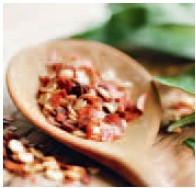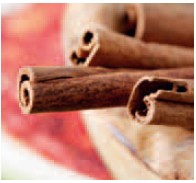Easy Indian Cooking (5 page)
Read Easy Indian Cooking Online
Authors: Hari Nayak

To prolong the life span of fresh herbs, like fresh coriander leaves (cilantro) and mint, wash and dry the leaves with a paper towel until the leaves are mostly dried. Store refrigerated, wrapped in a kitchen or paper towel, in a resealable plastic food storage bag.

Asian Chili Powder
This is a red powder made from grinding dried red skins of several types of chili peppers. In India, it is simply called “chili powder.” You can substitute cayenne pepper, which is commonly available in supermarkets. The Indian chili powder, which is darker in color than cayenne pepper, is available in Indian grocery stores. It adds a spicy flavor to dishes.

Bay Leaves
These are long, oval, pointed and smooth leaves of a hardy evergreen shrub. The leaves are dark green when fresh and turn olive green when dry. When fresh, the leaves are very mild and do not develop their full flavor until several weeks after picking and drying. They are often used whole, or sometimes ground in curries and rice dishes. They are an important ingredient in the Indian spice blend garam masala. Bay leaves are also a common fixture in the cooking of many European cuisines (particularly those of the Mediterranean), as well as North and South American cuisines. The bay leaf that is commonly available in North America is similar in appearance to the Indian bay leaf, but its flavor and fragrance are milder than the Indian counterpart. If you cannot find Indian bay leaves, which are often found only in Indian grocery stores, you may substitute regular bay leaves. The difference is very subtle and will not affect the final result.

Cardamom
The cardamom plant is native to India and Sri Lanka and is also cultivated in Guatemala, Mexico, Indonesia and other areas of southern Asia. The cardamom pods are harvested just before they are ripe and they are allowed to dry in the sun or sometimes in drying machines. There are two distinct types of cardamom pods used in Indian cooking: the small green pod and large black pod. The green pods are the most common and have exceptional flavor. I recommend using the green pods whenever cardamom is called for in this book. Black cardamom pods are used in Indian rice and meat dishes; however, they are not as commonly available.
Cardamom pods are used in almost every part of the cuisine, from savory dishes to curries and desserts. When using cardamom for desserts, the seeds are extracted from the pods and ground to a powder. For curries, stews or rice dishes, the whole pod can be added directly to the food. The sharp and bitter taste of cardamom mellows to a warming sweet taste as it cooks. The pre-ground preparation is more readily available than the pods in the West, whereas in India it is typical to find the whole pod. The quality of pre-ground cardamom is not as good as that found when freshly grinding the seeds at home. Once the pods are opened or the seeds ground, the flavor and aroma of the cardamom are lost very quickly. I especially recommend freshly grinding the seeds for the dessert and beverage recipes, where the spice often plays a particularly prominent role.
Chili Peppers
There are more than 150 varieties of chili peppers in the world. That’s a lot to keep track of, but as a general rule the smaller ones are hotter than the larger ones. The two most common chilies used in Indian cooking are the cayenne and Thai. The cayenne pepper is green when fresh and red when dried. The Thai variety, or “bird’s eye,” is smaller and hotter. The serrano chili is more widely available in the U.S. and is a good alternative to the cayenne and Thai, though it is milder. If you cannot find fresh cayenne, Thai or serrano chili peppers, simply use what’s available.

Fresh Chilies
These are one of the most important ingredients for providing pungency in Indian cuisine. In many regions in India fresh green chilies are served raw with the food. I often remove the inner membrane and seeds and use only the skin to reduce the heat. Chopping fresh chili releases capsaicin, and the finer you chop it, the hotter the taste. Sometimes I slit the chilies open, but leave the seeds intact to release a gentler heat.


Dried Red Chili Peppers
Whole dried red hot chilies, about 1½ to 2 inches (4 to 5 cm) long, are usually added to hot oil to infuse their strong flavor. A quick contact with hot oil enhances and intensifies the flavor of the skins. Indian dried red chilies are similar to most common types such as the cayenne and chili de arbol.

Cinnamon
This fragrant spice is the dried inner bark of the laurel tree. It is an important ingredient in Indian cooking, imparting a pleasant aroma to foods. It is sold in powder and stick forms. Whole sticks are used to flavor meats, curry and rice dishes as well as teas.

Cloves
These are dried unopened buds of a tropical tree. Deep reddish brown cloves add a strong fragrance to rice and grain recipes. It is also an important ingredient in garam masala. The cloves are lightly fried in hot oil, which perfumes the food subsequently cooked in the oil.

Coconut Milk, Coconut Meat, Shredded Coconut
In my recipes I use coconut milk, coconut meat and shredded coconut. Coconut milk is produced by crushing the thick white coconut meat that is inside the dark brown coconut shell. Water is added to the macerated mixture. It is then drained and the soaked coconut meat is squeezed to extract the liquid. As the milk sits, the fat rises to the surface. This fat is skimmed off and sold separately as coconut cream. The cream is much richer and thicker than the milk. Coconut milk and coconut cream are both sold in cans. When using coconut milk for savory recipes, make sure it is not sweetened. Sweetened milk or cream is used in making pastries and cocktails. I prefer to used full-fat coconut milk rather than the “lite” version, which is not as flavorful or creamy. Before opening a can of coconut milk make sure to shake it well, as the cream will have risen to the top; shaking the can incorporates the cream into the thinner milk-like liquid to create a smooth, even consistency. Once the can is opened make sure you store it covered in the refrigerator and use it within 2 to 3 days, as it spoils quickly.
